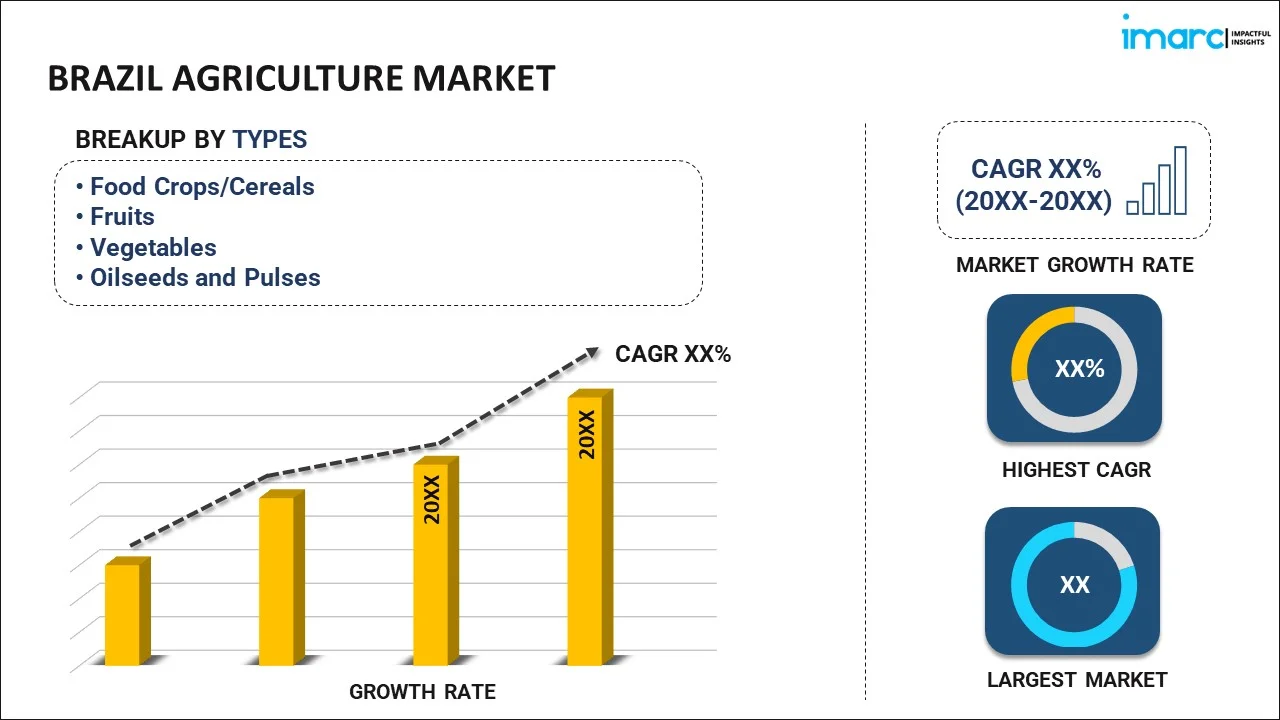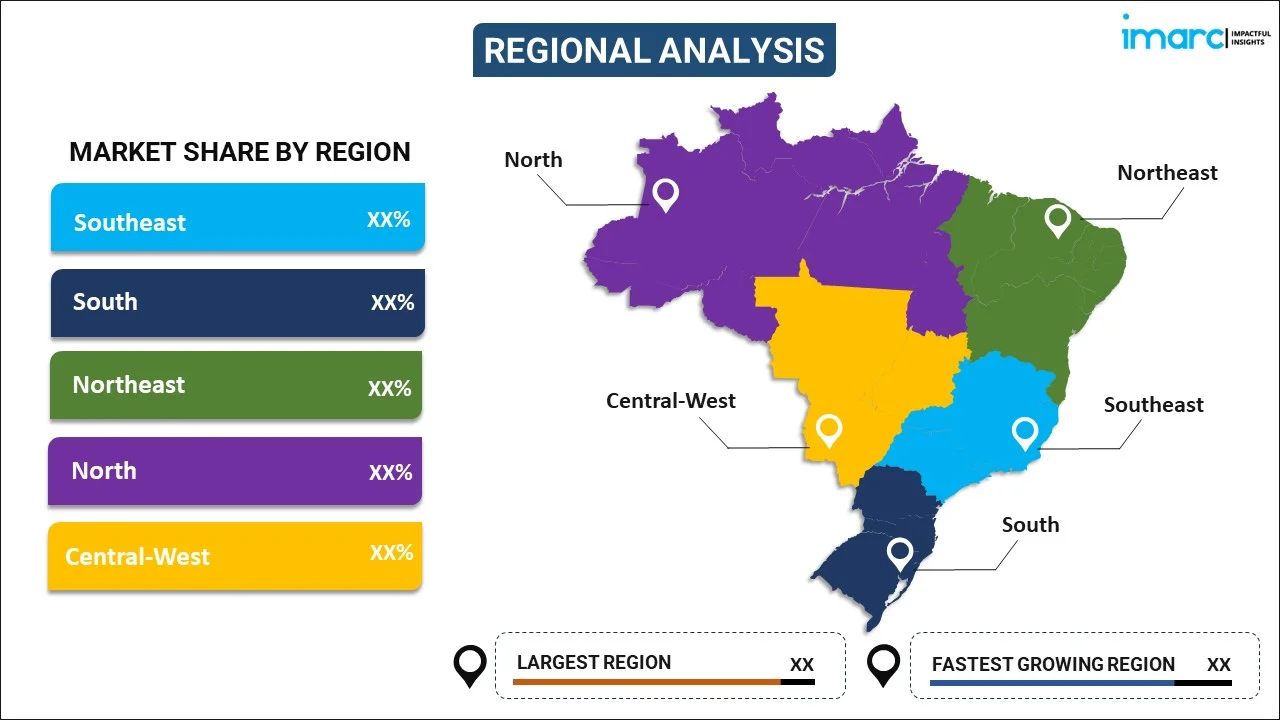
Brazil Agriculture Market Report by Type (Food Crops/Cereals, Fruits, Vegetables, Oilseeds and Pulses), and Region 2025-2033
Market Overview:
Brazil agriculture market size reached USD 126.6 Billion in 2024. Looking forward, IMARC Group expects the market to reach USD 171.9 Billion by 2033, exhibiting a growth rate (CAGR) of 3.46% during 2025-2033. The launch of various favorable policies by government bodies to support small-scale farmers, rising promotion of sustainable practices, high revenue generation and increasing export volume, and strong investments in R&D activities is primarily driving the market demand across the country.
|
Report Attribute
|
Key Statistics
|
|---|---|
|
Base Year
|
2024
|
|
Forecast Years
|
2025-2033
|
|
Historical Years
|
2019-2024
|
|
Market Size in 2024
|
USD 126.6 Billion |
|
Market Forecast in 2033
|
USD 171.9 Billion |
| Market Growth Rate 2025-2033 | 3.46% |
Agriculture is the practice of cultivating crops, raising livestock, and managing land for the production of food, fiber, and other commodities. Rooted in ancient human societies, it has evolved into a complex system involving advanced technologies and scientific knowledge. Agriculture generally encompasses a wide range of activities, from planting and harvesting crops to breeding animals. The agricultural sector plays a pivotal role in sustaining human life and providing the food necessary for nutrition and energy. It also contributes to economies, thereby influencing trade, employment, and rural development. Modern agriculture involves a blend of traditional practices and innovative techniques, including precision farming, genetic engineering, sustainable practices, etc., aiming to minimize environmental impact. As a dynamic and multifaceted field, agriculture is crucial for ensuring food security, economic stability, the overall well-being of individuals, etc.
Brazil Agriculture Market Trends:
Expansion of Arable Land and Modernization of Farming Techniques
The Brazil agriculture market share grows significantly due to the expansion of cultivable land and the use of modern farming technology. It has a substantial land area with extensive fertile soil, especially in the Cerrado region, which has been converted into productive farmland. Government efforts targeting infrastructure and land distribution have facilitated this growth, offering additional land for farming of important crops such as soybeans, corn, sugarcane, and coffee. Moreover, productivity has been enhanced by utilizing advanced irrigation systems, precision farming tools, and sustainable land management practices. Advancements such as GPS-guided tools, remote sensing, and soil analysis technology enable farmers to maximize water efficiency, cut expenses, and improve crop production. This modernization aims to keep Brazilian agriculture competitive globally, increasing exports and enhancing the ability of the sector to adapt to climate changes.
Strong Global Demand for Agricultural Exports
As per the Brazil agriculture market forecast, the country remains a top exporter of agricultural goods globally, with the expansion of the sector driven by ongoing strong international demand. Among the leading exports of the nation are soybeans, beef, sugar, and coffee, with key markets including China, the European Union, and the United States. The position of Brazil as a key food provider has been strengthened by the growing world population and higher demands for food safety. Due to lesser labor and production costs, agricultural products from Brazil are usually cheaper and more appealing to foreign buyers compared to products from other areas. Trade deals and beneficial export policies also help this process, enabling Brazil to enter new markets and increase its presence in current ones.
Investment in Sustainable Agriculture and Agroforestry
The Brazil agriculture market growth is fueled by sustainability, as government policies and private investments prioritize reducing environmental harm from farming practices. The country has been at the forefront worldwide in incorporating sustainable farming methods such as no-till farming, crop rotation, and agroforestry into industrial agriculture. These methods aid in preserving soil wellness, minimizing erosion, and promoting biodiversity. Moreover, the practice of agroforestry, which involves growing crops alongside protecting native forests, is becoming more popular as a way to harmonize agricultural output with environmental preservation. Corporations are also putting money into sustainable energy sources like biomass and solar power in order to lessen their impact on the environment. Brazil's involvement in worldwide sustainability efforts, like the Paris Agreement, and the increasing demand from global markets for products free of deforestation, are propelling the Brazil agriculture market demand.
Brazil Agriculture Market Segmentation:
IMARC Group provides an analysis of the key trends in each segment of the market, along with forecasts at the country level for 2025-2033. Our report has categorized the market based on type.
Type Insights:

- Food Crops/Cereals
- Fruits
- Vegetables
- Oilseeds and Pulses
The report has provided a detailed breakup and analysis of the market based on the type. This includes food crops/cereals, fruits, vegetables, and oilseeds and pulses.
Regional Insights:

- Southeast
- South
- Northeast
- North
- Central-West
The report has also provided a comprehensive analysis of all the major regional markets, which include Southeast, South, Northeast, North, and Central-West.
Competitive Landscape:
The market research report has also provided a comprehensive analysis of the competitive landscape in the market. Competitive analysis such as market structure, key player positioning, top winning strategies, competitive dashboard, and company evaluation quadrant has been covered in the report. Also, detailed profiles of all major companies have been provided.
Brazil Agriculture Market News:
- 30 September 2024: FMC Corporation has partnered with Ballagro Agro Tecnologia Ltda. to provide Brazilian growers with a wide range of biological crop protection solutions, aiming to strengthen its presence in the Brazilian market. The collaboration between FMC and Ballagro combines their expertise in microbial and fungi-based solutions to offer innovative, science-backed biological solutions to address evolving pest pressures and climate challenges faced by Brazilian growers.
- 1 May 2023: Bunge has launched a regenerative agriculture program in Brazil to help farmers transition to low-carbon agriculture, focusing on improving soil fertility, reducing greenhouse gas emissions, and promoting sustainability. The program offers technical support, customized action plans, and marketplace connections for participating farmers, covering approximately 250,000 hectares of land in six Brazilian states.
Brazil Agriculture Market Report Coverage:
| Report Features | Details |
|---|---|
| Base Year of the Analysis | 2024 |
| Historical Period | 2019-2024 |
| Forecast Period | 2025-2033 |
| Units | Billion USD |
| Scope of the Report | Exploration of Historical Trends and Market Outlook, Industry Catalysts and Challenges, Segment-Wise Historical and Future Market Assessment:
|
| Types Covered | Food Crops/Cereals, Fruits, Vegetables, Oilseeds and Pulses |
| Regions Covered | Southeast, South, Northeast, North, Central-West |
| Customization Scope | 10% Free Customization |
| Post-Sale Analyst Support | 10-12 Weeks |
| Delivery Format | PDF and Excel through Email (We can also provide the editable version of the report in PPT/Word format on special request) |
Key Questions Answered in This Report:
- How has the Brazil agriculture market performed so far and how will it perform in the coming years?
- What has been the impact of COVID-19 on the Brazil agriculture market?
- What is the breakup of the Brazil agriculture market on the basis of type?
- What are the various stages in the value chain of the Brazil agriculture market?
- What are the key driving factors and challenges in the Brazil agriculture?
- What is the structure of the Brazil agriculture market and who are the key players?
- What is the degree of competition in the Brazil agriculture market?
Key Benefits for Stakeholders:
- IMARC’s industry report offers a comprehensive quantitative analysis of various market segments, historical and current market trends, market forecasts, and dynamics of the Brazil agriculture market from 2019-2033.
- The research report provides the latest information on the market drivers, challenges, and opportunities in the Brazil agriculture market.
- Porter's five forces analysis assist stakeholders in assessing the impact of new entrants, competitive rivalry, supplier power, buyer power, and the threat of substitution. It helps stakeholders to analyze the level of competition within the Brazil agriculture industry and its attractiveness.
- Competitive landscape allows stakeholders to understand their competitive environment and provides an insight into the current positions of key players in the market.
Need more help?
- Speak to our experienced analysts for insights on the current market scenarios.
- Include additional segments and countries to customize the report as per your requirement.
- Gain an unparalleled competitive advantage in your domain by understanding how to utilize the report and positively impacting your operations and revenue.
- For further assistance, please connect with our analysts.
 Inquire Before Buying
Inquire Before Buying
 Speak to an Analyst
Speak to an Analyst
 Request Brochure
Request Brochure
 Request Customization
Request Customization




.webp)




.webp)












